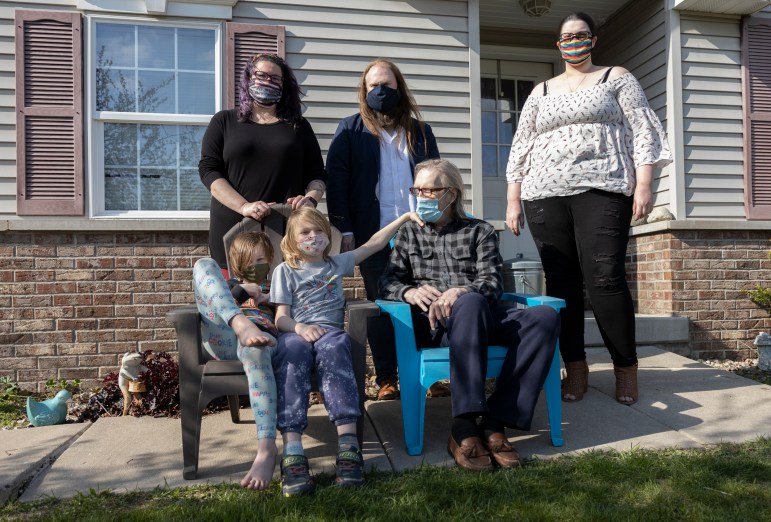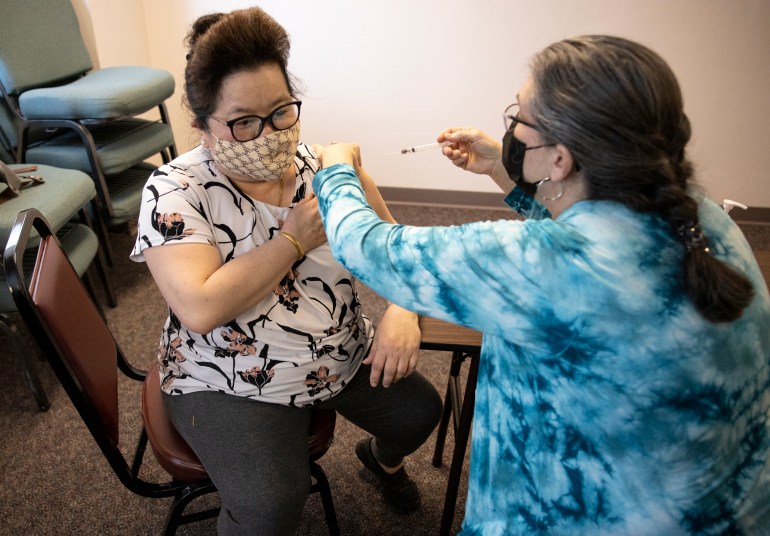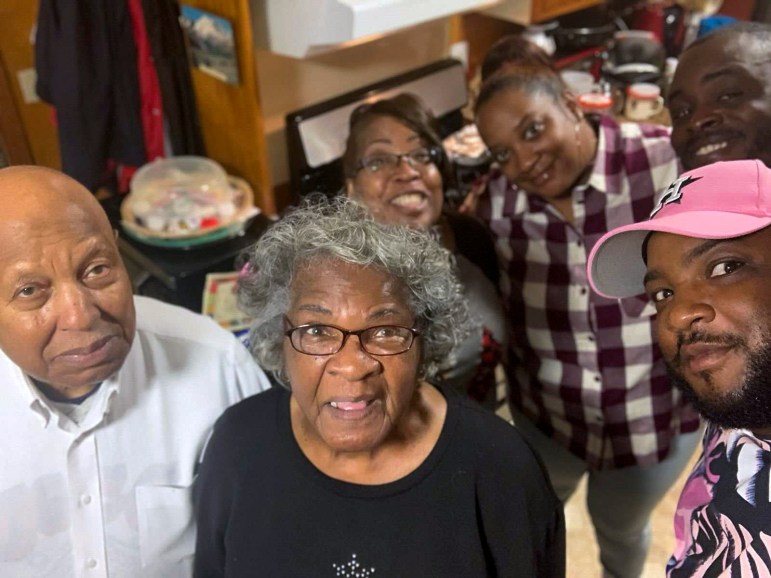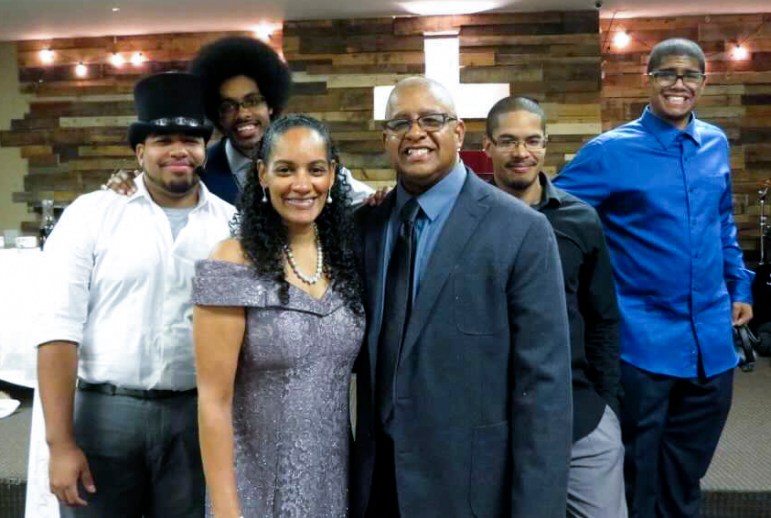Multigenerational Homes Hit Harder By COVID-19
13% of state residents, often families of color, face higher risks of infection and death.

The Brown family is a multigenerational family living in Madison, Wis.. Cassilyn Brown, top left, is a forensic nurse examiner at UnityPoint Health-Meriter Hospital. She feared bringing the coronavirus home to her family before most of the adults were vaccinated. So far, no family member has been infected with the virus. Also pictured in the top row are David Bingham Brown, center, and Ash Baker, right. Bottom row, from left, are: Victoria Brown, Alaric Brown and David Ralph Brown, 79, who has chronic pneumonia and a heart arrhythmia, which left him more susceptible to the virus. Credit: Coburn Dukehart / Wisconsin Watch
For many years, Cassilyn Brown’s home in Madison has housed three generations, including her husband, three children and father-in-law.
Since COVID-19 hit, her concerns about her family have grown as their multigenerational household works to stay safe from the pandemic, especially her 79-year-old father-in-law, who has chronic pneumonia and a heart arrhythmia.
Brown and her family welcomed her father-in-law, David Ralph Brown, into their family home back in Kentucky after the death of his wife in 2010. The family — including her husband, David Bingham Brown and their children Ash, Alaric and Victoria and a cockatoo named Casper — moved to Madison in 2014.
For Brown and her husband, this type of family dynamic was nothing new; both had lived with grandparents during their childhood. But the virus caused them to change family life as the younger elementary-aged children were warned from spending too much time close to their grandfather, who lives in the basement of the family’s three-level condominium.
Brown’s job as a forensic nurse examiner at UnityPoint Health-Meriter Hospital, where she cares for individuals suffering from sexual or and physical assault and violence, created another level of concern.
During the pandemic, she regularly monitored herself for the virus. But Brown feared the exposure to patients and the lack of personal protective equipment in the early part of the pandemic put her family at risk.
“We were given one N95 and told to reuse it until it became visibly soiled. And that was for use if you had a known COVID-positive patient, otherwise, we were working in a surgical mask,” said Brown, 43. “That had me very nervous.”
These days, she worries less. Brown, her 43-year-old husband and her father-in-law have received all of their shots. Their oldest child, who is 20, has not yet gotten the vaccine. No one in the Brown household has gotten sick from the virus.
But many families in Wisconsin, nationwide and elsewhere have not been so lucky. Studies in the United States and the United Kingdom found that older members of multigenerational households are at increased risk of death from COVID-19 — and ethnic and racial minorities are more likely to be part of such living arrangements.
Multigenerational households also often include essential workers, such as Brown, who are at greater risk of bringing the virus home. Brown recalls one such scare, which turned out to be a false alarm.
“I remember kind of panicking one morning, because I had a bag of licorice and I had gotten a piece of the licorice out of the bag and I couldn’t smell it right away. And that’s a very strong smell,” explained Brown. “It was a panic moment of ‘Okay, I’ve had an exposure, and I don’t know it, and now I potentially exposed everybody in the household.’”
For some, multiple generational homes common
The Center for Public Integrity found that 18% of U.S. households are multigenerational, containing at least two generations. That includes parents and adult children as well as families that extend from grandparents to grandchildren.
The CPI analysis of every county in the United States shows that people of color, at greater risk from the virus for a variety of factors, are far more likely to be living in the same home as older relatives: 30% among Latinos, 25% among Asians and 24% among Black families, compared to 15% for non-Latino white households.

Madison resident Chia Yang, 56, gets her first dose of the Moderna vaccine at a clinic put on by The Hmong Institute, in Madison, Wis., on March 9, 2021. Asian-American families in Wisconsin and nationally are more likely to live in multigenerational households, which are more at risk of contracting COVID-19. Credit: Coburn Dukehart / Wisconsin Watch
Just a handful of states have formally recognized COVID-19’s threat to multigenerational households and prioritized them for vaccination.
Wisconsin this month expanded vaccine eligibility to all state residents ages 16 and older, and it has funded programs to narrow the state’s wide racial disparities in COVID-19 vaccinations. But it is not among the states that prioritized multigenerational homes for vaccination. Washington, for example, became the first state to put multigenerational households near the top of its COVID-19 vaccine priority list on Jan. 6.
Washington’s rollout hasn’t always been smooth, according to some activists representing communities of color who pushed for it. But prominent virus experts are urging other jurisdictions, as vaccine supplies grow, to also target multigenerational homes as an effective way to reach communities of color.
Wisconsin has about 325,000 multigenerational households, or 13% of all households — lower than the national average — but the racial disparity is similar. Among Black households, 19% contain multiple generations, according to CPI data analyzed by Wisconsin Watch. About 20% of Hispanic and 23% of Asian households in Wisconsin contain multiple generations, the analysis showed.
Counties with a high percentage of multigenerational households include Kenosha, Racine, Rock, Milwaukee and Waukesha. In four of those counties — Kenosha, Milwaukee, Racine and Rock — the percentage of fully vaccinated residents ranked at or below the state’s average of 31.5% as of Monday morning, according to data from the Wisconsin Department of Health Services.
In-home infection hits people of color
Nationwide, these households include millions of Americans and immigrants who live with extended family to suit elders’ needs, for cultural reasons or because it’s more affordable.
“Inside-the-home transmission is what has been killing so many older people of color,” said Dr. Ashish Jha, a leading global public health expert and dean of the Brown University School of Public Health.
But early vaccination of essential workers “alone probably is not enough,” Jha said. “We really do need to find ways to prevent the intergenerational spread of the infection in these households.”
These households often consist of people of color, who have less access to health insurance and higher rates of health problems that make COVID-19 more deadly.
Focusing vaccine access on the most vulnerable demographics, regardless of age, would require prioritizing minority populations because they have more underlying health conditions, said Dr. James Hildreth, president of Meharry Medical College, a historically Black medical school in Nashville, Tennessee.
“What’s keeping that from happening is that it appears to be prioritizing based on race, and in today’s United States,” Hildreth said, “that’s just not gonna fly.”
‘It felt like we were invisible’
As anticipation of a vaccine release grew last year, leaders in the state of Washington’s immigrant communities and communities of color asked the state to designate multigenerational families as an early high priority.
About 22% of Asian households in the state are multigenerational. But “it felt like we were invisible,” said Seattle resident Trang Tu, who lives with and cares for her 90-year-old mother.
Last summer, a federal advisory group tasked with developing plans for fairly distributing the vaccine began wrestling with the concerns of multigenerational families. The advisers suggested that local officials have latitude to vaccinate entire households regardless of age if experts thought it would be more efficient and equitable at protecting vulnerable communities.
Tu, 48, joined a Dec. 20 Zoom meeting for the public with representatives of the Centers for Disease Control and Prevention. Knowing that vaccine would be in short supply initially, CDC advisers had already recommended Dec. 1 that vaccines first go to health care workers and residents of long-term care facilities where outbreaks had been so deadly.
The CDC also issued a statement at the time suggesting that as vaccine supply increased, it was open to future recommendations prioritizing multigenerational households.
COVID-19 fatality rates in Washington have been disproportionately higher among households of color — a trend seen nationally and in Wisconsin. Since the pandemic began, the death rate among Native Hawaiians and Pacific Islanders in Washington has been six times higher than for white residents. Latino, Native American and Alaskan death rates have been three times higher. And it’s been nearly twice as high for Black residents.
By mid-April, all U.S. states had opened vaccine eligibility to all adults. But before that expansion, when timing was a matter of life or death, at least three other states adopted versions of Washington’s policy.
Alaska began vaccinating people 45 and older in multigenerational households in February. The Alaska Tribal Health System was already doing this. Crucially, older adults may be more inclined to get vaccinated when they can do so with a family member, said Clinton Bennett, a spokesman for the Alaska Department of Health and Social Services.
In early March, Minnesota began expanding eligibility to people 50 and up in homes with at least three generations, such as a grandparent, parent and grandchild.
Oregon also has targeted multigenerational households for vaccines. Officials in Multnomah County, home to Portland, plan to consult with community organizations on which types of households should qualify.
COVID-19 high in multigenerational counties
Some of the counties Public Integrity found to have exceptionally large concentrations of multigenerational households have also been ravaged by COVID-19.
In Wisconsin, counties with the largest percentage of Latino multigenerational households also have seen some of the state’s highest proportion of positive COVID-19 cases. Menominee County, which ties for third highest percentage of Hispanic multigenerational homes at 30.6%, has seen the highest share of its population testing positive. In all, 792 of its 4,579 residents — that’s almost one out of six people — contracted the virus as of Monday morning, according to state data.

The Fuller family, back left, Arva, and her daughter Paege, and her son (not pictured) are three generations living under one roof in Mississippi. They spent a year worrying that one person could catch the coronavirus and share it with Paege’s grandparents who live nearby, Willie and Mildred Belt, at left. Credit: Courtesy of the Fuller family
Similarly, in the Latino-majority border community of Webb County, Texas, 36% of households are multigenerational, one of the highest concentrations in the country. At least one in six residents has been infected, and close to 30% of residents lack health insurance. In two California counties, San Bernardino and Imperial, two majority Latino counties, 30% of households are multigenerational. Elsewhere in the country, these households are common among white families in West Virginia, Kentucky and other parts of Appalachia.
The South is home to large proportions of Black multigenerational households, especially in the Mississippi Delta.
Paege Fuller, 35, and her son, 11, moved back to Jackson from Houston, Texas, after she lost her job due to the pandemic. Fuller is Black, as is 38% of Mississippi’s population. Although Black residents account for roughly 39% of COVID-19 deaths, the state estimates they were only 28% of those vaccinated through March 22.
Fuller lives with her mother, who works outside the home. She helps her grandparents, 86 and 87, who live nearby, shop and attend church virtually on an iPad. Fuller struggled for days to make a vaccine appointment for them, too. Her grandparents finally got shots in February. But the whole family is still fearful, especially as variants of the virus circulate that may be partially resistant to the vaccine.
“Those are my grandparents,” Fuller said. “They took care of me, so it’s my time to take care of them, and I want them around as long as possible.”
The Muriels, a Latino family in Florida’s Hernando County, know how easily the virus can spread inside a larger household. In their Gulf Coast community north of Tampa, about 19% of households are multigenerational, one of the biggest concentrations in Florida. The Muriel household includes Kathy, 59, her husband, 58, and four sons, ages 24 to 32. They all tested positive for COVID-19 last year.

Kathy, 59, and James Muriel Sr., 58, center, celebrate their wedding anniversary. From left: James, 32; Steven, 27; Michael, 29; and Martin, 24. The multigenerational family in Hernando County, Fla. all tested positive for COVID-19 last year. Homes containing multiple generations of adults are at higher risk of spreading COVID-19. Credit: Courtesy of the Muriel family
The family tried to fend off the virus with hand washing, masks and distancing in public. But it was unnatural to be so careful at home. “By the time we figured out, ‘I think you may have COVID,’ we all went down within a week’s time,” Kathy Muriel said.
For months last summer, the family fought the virus’ stew of symptoms: sore throat, body ache, fever chills, fatigue and eyeball pain. They’ve all recovered but worry that a variant could return like an unwanted and potentially deadly guest.
In California, Imperial County public health workers fan out before dawn to find farmworkers to vaccinate. They hope their focus helps protect members of multigenerational families, close to one in three of all households here. In Los Angeles County — 27% multigenerational — labor activists also pushed for vaccinating people at work to try to protect hard-hit blue-collar households.
Imperial is one of America’s primary vegetable-growing regions, with workers toiling through the pandemic. Last June the county had the highest COVID-19 death rate in California. It’s still a high-risk community, with at least one in seven people estimated to have been infected.
California health officials have a different approach to reach multigenerational families in Imperial and similar counties. The state is sending 40% of its vaccine supply to ZIP codes in the lowest quartile of an index it calls Healthy Places. One factor in that score: how crowded the housing is.
The rise in multigenerational living
As of 2016, more than 64 million Americans lived in multigenerational households, which often sees a mixture of grandchildren, young and adult children, parents and their parents all living together, according to the Pew Research Center.
“Our country was founded by multigenerational families and that’s how people were able to farm and how they were able to survive —- it was by pooling their resources,” explained Donna Butts, the executive director of Generations United, a national organization that aims to strengthen intergenerational connections.
Butts sees this trend, particularly during the pandemic, making a comeback: “Multigenerational families are on the rise, and they’re here to stay.”
But due to the economic pressures, fears of sending relatives to nursing homes and assisted living and the shifts to remote working and schooling, the number of multigenerational households have now hit 15% — with nonwhite families driving that trend, according to the most recent data.
“We certainly are seeing that minorities are embracing this way of living at higher shares than we do see for white families,” said Jessica Lautz, the vice president of demographics and behavioral insights at the National Association of Realtors.
Marci Spoke of Milwaukee is part of that trend.
Since the loss of her husband — and more recently her daughter — Spoke, who is white, became the sole head of the household for a home that includes her son, Greg, 51, who is on the autism spectrum, and her two biracial grandsons, Brion and Anthony, ages 22 and 16.
In her job with the Salvation Army as an on-call chaplain for the Milwaukee Police Department, Spoke, 68, comforts grieving families, where she runs the risk of being exposed to COVID-19. Her eldest grandson also works outside their home.
But while Spoke tries to carry on with her life as safely as possible, she has had to limit or completely stop any in-person interactions with some of her other family members, including a sibling who does not believe in COVID-19.
“There were a lot of times that I’d get in the car and I’d put sanitizer over everything,” Spoke explained. “But, still, you gotta have faith that you could do it, help people and still live.”
Wisconsin Watch (wisconsinwatch.org) collaborates with WPR, PBS Wisconsin, other news media and the University of Wisconsin-Madison School of Journalism and Mass Communication. All works created, published, posted or disseminated by Wisconsin Watch do not necessarily reflect the views or opinions of UW-Madison or any of its affiliates.
More about the Coronavirus Pandemic
- Governors Tony Evers, JB Pritzker, Tim Walz, and Gretchen Whitmer Issue a Joint Statement Concerning Reports that Donald Trump Gave Russian Dictator Putin American COVID-19 Supplies - Gov. Tony Evers - Oct 11th, 2024
- MHD Release: Milwaukee Health Department Launches COVID-19 Wastewater Testing Dashboard - City of Milwaukee Health Department - Jan 23rd, 2024
- Milwaukee County Announces New Policies Related to COVID-19 Pandemic - David Crowley - May 9th, 2023
- DHS Details End of Emergency COVID-19 Response - Wisconsin Department of Health Services - Apr 26th, 2023
- Milwaukee Health Department Announces Upcoming Changes to COVID-19 Services - City of Milwaukee Health Department - Mar 17th, 2023
- Fitzgerald Applauds Passage of COVID-19 Origin Act - U.S. Rep. Scott Fitzgerald - Mar 10th, 2023
- DHS Expands Free COVID-19 Testing Program - Wisconsin Department of Health Services - Feb 10th, 2023
- MKE County: COVID-19 Hospitalizations Rising - Graham Kilmer - Jan 16th, 2023
- Not Enough Getting Bivalent Booster Shots, State Health Officials Warn - Gaby Vinick - Dec 26th, 2022
- Nearly All Wisconsinites Age 6 Months and Older Now Eligible for Updated COVID-19 Vaccine - Wisconsin Department of Health Services - Dec 15th, 2022
Read more about Coronavirus Pandemic here
-
Legislators Agree on Postpartum Medicaid Expansion
 Jan 22nd, 2025 by Hallie Claflin
Jan 22nd, 2025 by Hallie Claflin
-
Inferior Care Feared As Counties Privatize Nursing Homes
 Dec 15th, 2024 by Addie Costello
Dec 15th, 2024 by Addie Costello
-
Wisconsin Lacks Clear System for Tracking Police Caught Lying
 May 9th, 2024 by Jacob Resneck
May 9th, 2024 by Jacob Resneck





















